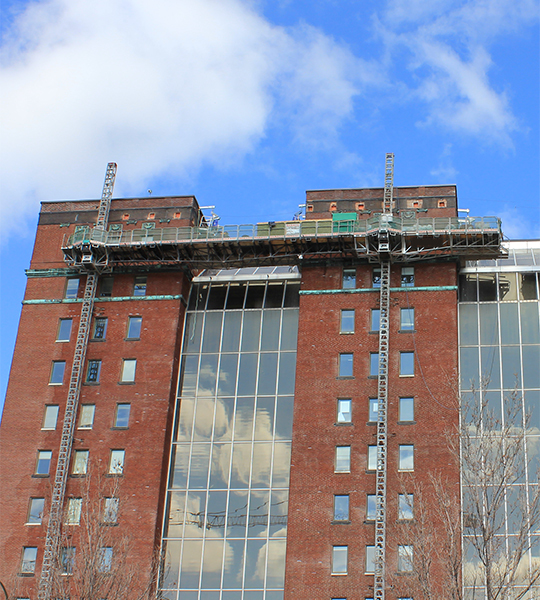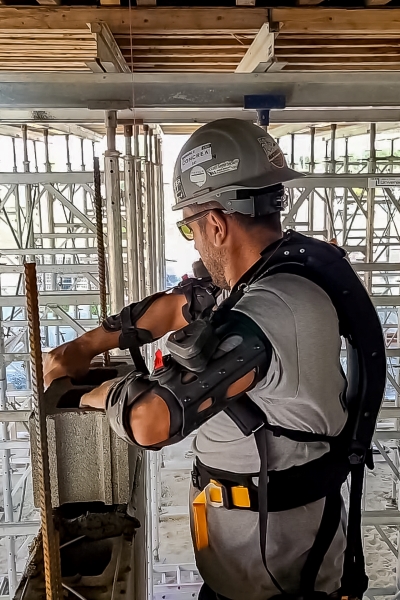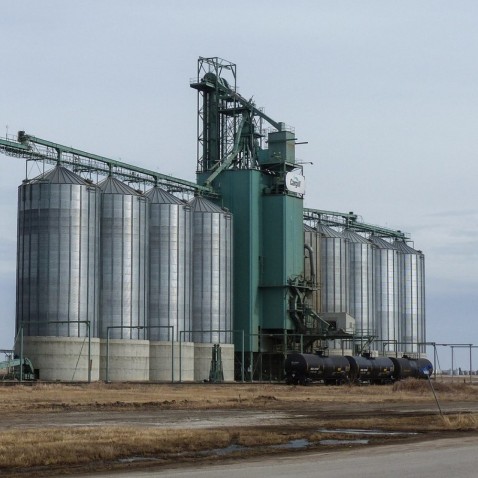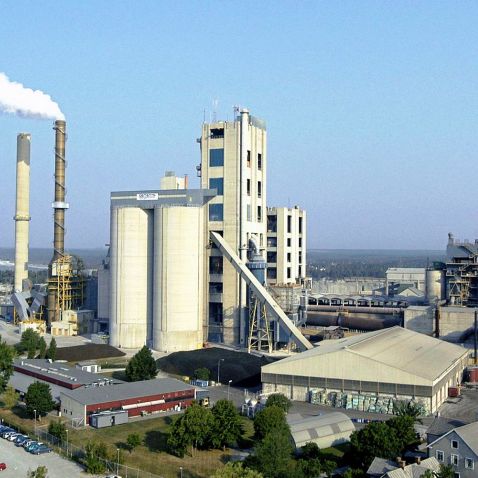Safety on Mast-Climbers
Safety on Mast-Climbers
What can go wrong?
When it comes to working on a mast-climbing platform, the most prevalent risks revolve around the peril of falls, be it objects or individuals, and the potential collapse of the platform. While other hazards like electrical and environmental factors demand attention, our focus remains on the primary risks contributing to the majority of accidents. Beyond these immediate dangers, there's a concern for the long-term health implications for masons tasked with repetitive and strenuous activities.
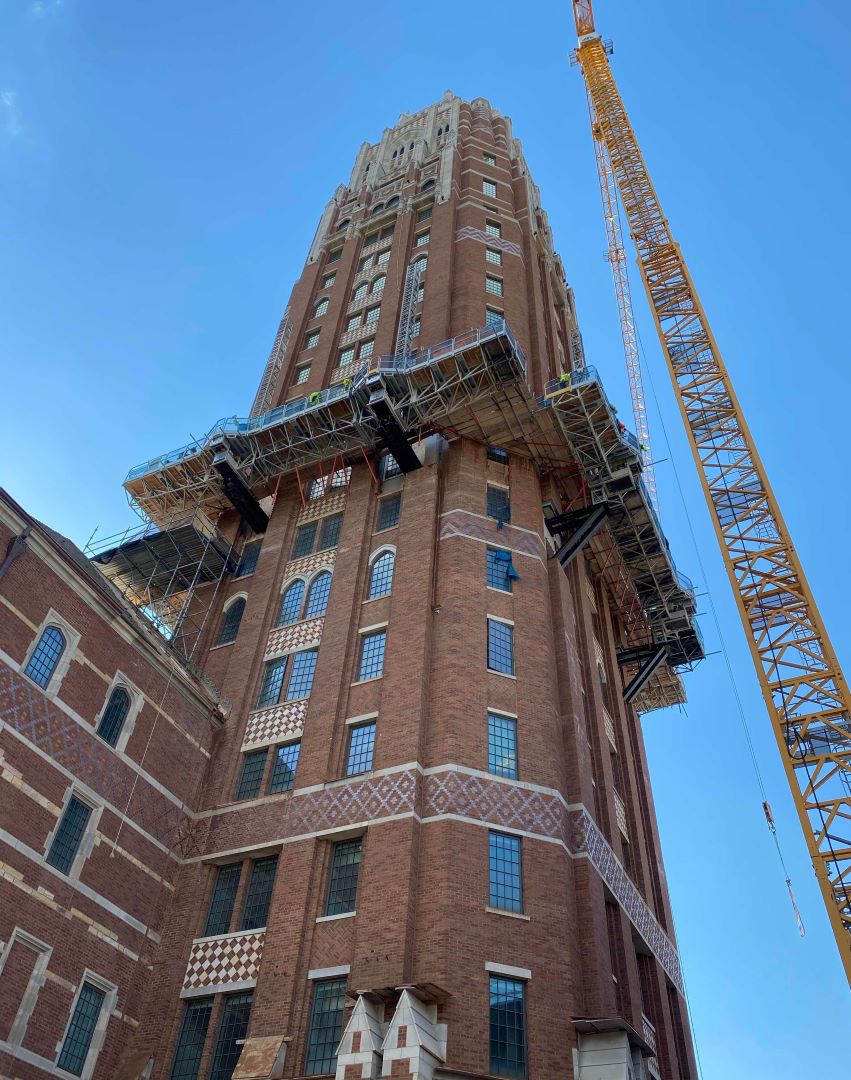
Ergonomics against falling and back pain.
The ergonomic design of mast-climbing platforms effectively addresses the risks associated with falling and long-term health concerns for workers. Each platform is equipped with guardrails. Platforms safely transport the workers and equipment up and down. Mast climbers offer adjustable elevation, allowing workers to carry out tasks within safe zones without the need for bending or reaching overhead. Additionally, various features such as adjustable working tables on the platforms help mitigate potential long-term health risks by ensuring tasks are performed at optimal levels.
The perfect technology.
In addition to the ergonomic features that prioritize worker safety, mast-climbing platforms incorporate an array of safety devices strategically integrated throughout their structure, effectively doubling or even tripling risk mitigation efforts. For instance, the platform's rear section is engineered to prevent overturning; if any bending is happening, the structural parts of the construction (the frame and safety pins, to name some) will swiftly intervene, stabilizing the platform and averting potential disasters.
Furthermore, climbing mechanisms are outfitted with emergency safety devices that activate in case of a free fall. These safety devices will either (depending on the technology used) instantly catch and stop the platform or quickly and smoothly break the platform's downward movement, allowing for a safe evacuation. Should one device malfunction, backup systems are in place to ensure uninterrupted safety measures, providing an additional layer of protection.
Beyond these visible safety features, mast-climbing platforms also often incorporate latent safety mechanisms to safeguard against platform misuse. For example, the Fraco 20K platform (load capacity of 10,000 lbs for one mast) is equipped with a built-in power restriction feature that shall prevent the operation of the unit when it is overloaded beyond the manufacturer's specifications.
Modern platforms frequently come equipped with integrated alarm systems designed to promptly notify operators of any unforeseen events. Additionally, platforms configured in a bridge formation may feature an inclinometer system. This specialized setup detects any asynchronous movement, triggering an alarm signal when the bridge reaches a predetermined angle. In cases where the bridge surpasses this angle, the inclinometer system automatically shuts down power to prevent potential damage to both the equipment and its users.
Thus, modern mast-climbing platforms are safe by design. Then why do accidents still occur?
Human factor
The majority of accidents, according to Francois Villeneuve, Fraco VP of Engineering and a member of the ANSI sub-committee, happen during the installation and dismantling of mast-climbing platforms and are mostly caused by human error. The installation and dismantling team, as well as the operator of the platform, must always be trained and authorized. At Fraco, this training typically spans 4 to 6 days and covers both theoretical and practical aspects.
So, what are the most common reasons for the accidents:
Rushing
Often the workers neglect following the instructions because they are pressed for time. Sometimes the workers simply do not go over safety checklists or overlook steps that may cause them to forget to attend to seemingly insignificant parts, like putting, for example, the exact number of bolts of proper size and grade into the anchor.
False confidence
False confidence can sometimes cause workers to disregard important instructions. Francois Villeneuve recounts a tragic incident where two installers were erecting a mast for a platform. When the time of their lunch break stuck, realizing they lacked the necessary bolts to complete the installation, they hastily secured the mast with the two remaining bolts, intending to finish the installation after lunch. Unfortunately, they forgot to follow through on their plan and proceeded to hoist the platform onto only nominally secured mast. The heartbreaking outcome? The lives lost in a tragic incident that could have been prevented.
Ignoring the environment
Taking into account the environmental factors is crucial for safety on mast-climbing platforms. For instance, when lifting and positioning heavy loads on the platform, the impact of wind force must not be underestimated. Additionally, the safety of the installation, especially if the platform is not freestanding, relies heavily on the stability of the walls or structures to which it is anchored. During restoration projects, it's crucial to recognize that even the strongest platform cannot withstand a weak wall.
Risky Ingenuity
The variety of architecture demands a variety of access solutions. To adjust the platform to unusual architectural forms and work scenarios, the workers are sometimes tempted to introduce improper ‘improvements’ to the design on the platform. For example, if something sticks out of the building, the installers may decide to anchor the platform higher or lower to avoid the obstacle. This might lead to unplanned strain on the structure….
In case of a need, mast-climbing platforms can indeed be configured to suit various architectural shapes and projects. Fraco routinely customizes its platforms to accommodate even the most unusual architectural designs and projects (twisted masts, inclined masts, curved walls). However, these modifications are exclusively handled by in-house engineers and undergo rigorous testing before implementation to ensure safety and reliability.
Accumulation of small neglects
Very often, tragedies happen due to the accumulation of small seemingly insignificant factors. For example, due to neglect in maintenance, and poor storage conditions, the equipment can get damaged over time. And if the daily and periodical inspections are not rigorously performed, that damage can go unnoticed.
Don’t cheat, don’t rush, don’t overload!
Answering the question ‘If you were to give only 3 rules to mast-climbing platform users, what would they be?’

Francois Villeneuve, VP of Engineering gave the following three:
1. Training first – no untrained workers on the platform!
2. Never rush – do not leave the tasks incomplete.
3. Respect load capacity and the positioning of the loads on the platform.
Unsurprisingly, answering the same question, Fraco Training and Development Manager Shanon Beekman produces rather similar responses:
1. Read the user manual and be familiar with the product.
2. Receive proper training to be on or to operate the platform.
3. Be observant and speak out, look out for your safety and others around you.
To summarize, to work on the platform, training is a must. First, the platform, though looks simple, is quite a sophisticated machine, you can’t drive it without the ‘license’.
Second, read the manual and respect the rules. Nothing is too small to adhere to.
And lastly, watch out! Use your common sense, most of the potential risks about mast-climbing platforms are intuitively comprehendible, like you can’t load only one side of it, or you can’t use it when the wind is too strong, or you shouldn’t be on a machine with missing guardrail without wearing a fall prevention safety harness hook to a designated attach point.
More Info:


